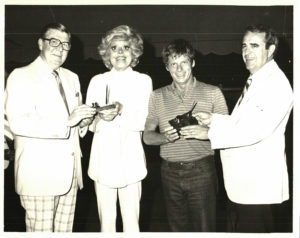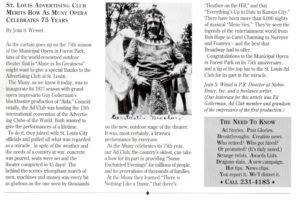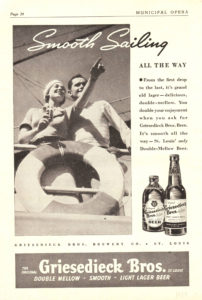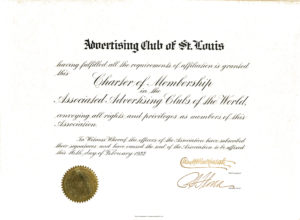1917 – When the advertising world came to St. Louis (Part 3)
Advertising women play a role in the convention
There’s little doubt that these early conventions were male-dominated, however, advertising clubs from New York, Boston, a few others plus members of the Woman’s Advertising Club of St. Louis did participate and the battles for the full rights of women were being fought hard in 1917.
To most accurately describe the challenges and contributions of women involved in early 1900s advertising, it may be best to quote directly from the stories of the day.
The Atlanta-Constitution reported in Advertising Women To Have Place on Convention Program (May 6, 1917), “Women attending the annual meetings of the advertising clubs naturally divide themselves into two classes – the wives, mothers and daughters of the delegates, who attend few of the session and really go for a good time on one hand, and the businesswomen, who attend all sessions and none of the day-time entertainment features, on the other. Among the other sectional meetings at the St. Louis convention will be a conference of advertising women, and such a meeting during the Philadelphia convention of the association a year ago was attended by more than 100 women who earn their daily bread in the advertising profession.
Because women folk do most of the buying, it has been urged that there should be still more women in the advertising business, although many of the women now engaged in the business are not writing advertisements for women alone. A good many would be surprised if they could see the advertising manager of one of the big advertising safety razor companies. Letters from this advertising manager selling razors to mere men, mind you – signs advertising department letters O. A. Cole – but when the name is written in full it is Olive A. Cole, and Miss Cole, who attends the advertising conventions and is just as womanly as she is capable, has made a signal success of the business. She and others now in the field of advertising believe that women will eventually occupy a most prominent place in advertising, just as they do already in so many other lines.” By the way, that safety razor company that Miss Olive A. Cole ran the advertising for was none other than the Gillette Safety Razor company.
The St. Louis Post-Dispatch also highlighted the women’s involvement during the convention in their June 3, 1917, story, “Women Share in Convention on Advertising.” The Advertising Women’s Conference portion of the convention met in the Advertising Club of St. Louis headquarters in the Mercantile Club building at 7th and Locust Streets. According to the Post, “Conference is composed of six distinctive advertising women’s organizations affiliated with the Associated Advertising Clubs of the World. Some of the men’s affiliated advertising clubs admit women actively engaged in the advertising profession to full membership. This privilege is a matter of local policy The Advertising Club of St. Louis does not admit women to membership. The members of the Women’s Advertising Club of St. Louis, however, are admitted to all business sessions and entertainments, and to all departmentals of the AAC of W at its thirteenth annual convention.”
As a side story, it took decades for the Women’s Club and the Ad Club to officially merge, even though the St. Louis advertising women were pioneers in many areas. Mary Kimbrough wrote in the 100th Anniversary celebration booklet The History of the Advertising Club of Greater St. Louis, “A highlight of the club’s evolution occurred June 1, 1988. The Women’s Advertising Club (which had changed its name to the Advertising Federation of St. Louis, admitting men to its membership) merged with the Advertising Club of Greater St. Louis. Prior to this event, the women’s group pioneered a niche for female advertising professionals. Their club also dedicated itself to civic and social betterment and, of course, fun. Under the chairmanship of famed ad exec Bea Adams back in 1930, the members had created their own Gridiron, ultimately contributing well over $1 million to Barnes Hospital for cancer research. They also instituted the annual Flair Awards competition, honoring advertising from the Ninth District Federation.
As the Federation of St. Louis had opened its doors to men, the Advertising Club of Greater St. Louis had opened its membership to women. In 1986, Mary Lou Hess became the first woman president of the Ad Club.”
Returning to the Post-Dispatch story from June 3, 1917, “A large number of women have entered the advertising field, and many are entirely successful. It is but natural that a woman should succeed in the advertising profession, in that 80% of the incomes are dispersed by woman, and a clever woman advertising writer, the women argue, know better the text that would appeal to women than men. Women are writing all lines of advertising from household commodities and conveniences to safety razors, men’s wearing apparel, automobiles and heavy machinery.
Miss Jane J. Martin, New York, advertising manager for the Sperry-Hutchinson Co., is the chairman of the Advertising Women’s Conference. She is one of the highest salaried advertising writers in this country, as she receives $10,000 a year. She started as a $10 a week stenographer. In a recent interview, Miss Martin said, ‘I believe there is a big field for women in advertising. There are about 250 advertising women in New York, including ten or a dozen managers. The rest are agency women, artists, layout women and solicitors. Women have official standing in the Associated Advertising Clubs of the World. There has been a prejudice against women in advertising, but it is disappearing. More than 50 percent of the businessmen of today are willing to let a woman go just as far as her ability to take her.”
The following St. Louis women were mentioned specifically in the Post-Dispatch article: “The officers and members of the Women’s Advertising Club of St. Louis, which is the youngest organization are: Miss Daisy E. Nirdlinger, president; Miss Elizabeth Cueny, vice president; Miss Florance Burk, secretary, and Miss Mabel Copley, treasurer. Other members are Misses A. Avery, Edna Amrein, Anita Moore, Mary Semple Scott, Lillian Dudley, V.A. L. Jones, I. A. Rohannon, Mrs. Julia S. Carroll, Miss Mamie Gerhard, Mrs. M.W. Huyette, Mrs. S.M. Beers, Mrs. H. E. Wagoner, and Miss Louis LeNoir Thomas.”
We would love to speak with family members of the women mentioned in the Post-Dispatch article and learn more about these women advertising trailblazers. If you have any information on these women, please contact ken@stlmediahistory.org.
Entertainment of the Convention
Perhaps one of the most enduring and lasting legacies of the 1917 AAC of W convention was the construction of a permanent open-air municipal theater in Forest Park. In June 1992 during the 75th anniversary of the Muny Opera, Jean Wessel and Ed Golterman, Ad Club member and grandson of Grand Opera Committee supervisor and well-known opera promoter, Guy Golterman, wrote the following in the St. Louis Advertising magazine:
“The Muny, as we know it today, was to inaugurate its 1917 season with grand opera impresario Guy Golterman’s blockbuster production of ‘Aida.’ Coincidentally, the Ad Club was hosting the 13th international convention of the Advertising Clubs of the World. Both wanted to give the performance of a lifetime. To do it, they joined with the St. Louis City officials and pulled off what was regarded as a miracle. In spite of the weather and the needs of a country at war, concrete was poured, seats were set and the theater completed in 45 days! The behind-the-scenes triumphant march of men, machines and money was every bit as glorious as the one seen by thousands on the new, outdoor stage of the theater. It was, most certainly, a bravura performance by everyone.”
Music played a major role in the 1917 convention. Most of it was patriotic in nature, but the evening of June 5th was dedicated to Aida and advertising. The production of Aida promised to be spectacular, and it was Golterman who suggested it as special entertainment for the conventioneers. The prior year a well-attended Shakespearian production “As You Like It” took place in Forest Park on the naturally sloping amphitheater that would be designated as the site of the new municipal opera.
Again, city leaders fully supported the construction although the expenses were borne by the Advertising Club who promised to buy $5,000 in tickets and contribute $25,000 of its convention budget to the city. Other contributors included the St. Louis Style Show, the Parks Department, and the Grand Opera Committee. Parks and Recreations Commissioner Nelson Cunliffe announced that 50 men and 15 teams would grade the land and form the building and seats. Concrete started pouring in mid-April and by the end of May they were putting on finishing touches for the early June premier. A pretty incredible feat and testament to civic progress begun by the Advertising Club and its members.
A few notes about the performance of Aida itself and why it was so spectacular. According to Associated Advertising June 1917, “Aida as it has commonly been presented in the past has called for a chorus of 40 or 50 voices and a ballet of a dozen or fifteen, but the St. Louis performance is going to be cast upon a plane similar to that which marked the first performance of this opera, which is considered Verdi’s most tuneful piece, at Cairo in 1871.” So, what does that mean? In typical St. Louis advertising style, we went big. Golterman’s production of Aida included a chorus of 500 and a ballet of 60, the St. Louis Symphony performed with 110 pieces, and the stage manager came from the Boston-National Grand Opera Company.
The St. Louis community also got involved. The Post-Dispatch quoted Parks and Rec Commissioner Cunliffe about the future of the Muny on June 17, 1917, “The aim will be to keep the entertainment standard of the theater high. Commonplace things should not be offered there. On the other hand, dramatic and musical art should be shown in such a way as to popularize them. The best use of the municipal theater will be found in making the greatest use of the community plan. In Aida, nearly 400 singers in the chorus represented the leading vocal societies of the city, which could not have been brought together except by a public event of that kind.”
The Advertising Club has long been a gathering place for the creative community and the Muny Opera was the perfect backdrop. In 1925, the New York Times wrote, “In these open-air theatres St. Louis has been a pioneer among American cities and a leader in a movement which is spreading rapidly through the Middle West. In St. Louis, this entertainment outrivals the movies during hot weather, which, even in hot weather says something.” (The New York Times, What the St. Louis Municipal Theater is Doing With Opera July 12, 1925, pg. X5)
Post-script and Lasting legacies
One of the fun things about reading history is connecting the dots. In an earlier blog post, we introduced Branch Rickey and highlighted the Advertising Club of St. Louis plaque honoring those who fought in the war. We’ve always wondered why the WWI plaque was so substantial and ornate. In future blog posts, we’ll share reproductions of the actual minutes from Ad Club St. Louis meetings that tell the full story of the plaque and its commissioning. Recently though while researching the convention in the Associated Advertising July 1917 magazine, we read this brief two-paragraph mention of a resolution passed in St. Louis that helps explain this plaque and others like it in support of our Armed Forces:
“Members of advertising clubs in the service of the country will be carried without dues pending their return to commercial pursuits under the terms of a resolution adopted at the St. Louis advertising convention.
The resolution suspending national association dues in such cases suggested that each advertising club have an honor roll upon which all such names shall be placed.”
St. Louis took the suggestion of an honor roll seriously and produced a beautiful plaque for all to see.
The 1917 St. Louis convention was a pivotal moment for the nation’s advertising professionals. The Truth-in-Advertising movement helped launch the AAF, the 4As, the Better Business Bureau and brought legitimacy to a still relatively new profession. All across the country, men and women advertising practitioners used their skills to support the nation through Liberty Loans, Red Cross, and recruitment efforts.
On the local front, thanks to the support of Mayor Henry Kiel, the leadership of William D’Arcy, the pioneering spirit of the Woman’s Advertising Club, the vision of Guy Golterman and the Grand Opera committee in spearheading The Muny, and the hard work of the entire Advertising Club of St. Louis, the world saw first-hand what a wonderful advertising community St. Louis is and remains still today.
Be watching for our next blog post as we introduce another one of St. Louis’ interesting and influential personalities: Gardner Advertising Vice-President Erma Perham Proetz, at one time the highest-paid woman executive in St. Louis and the first woman elected to the AAF Advertising Hall of Fame.
- Miss Olive A. Cole was advertising manager for Gillette Safety Razors and an advertising woman trailblazer. This article from Associated Advertising December 1915 issue discusses her career. She was active in the Boston Women’s Publicity Association and a speaker at the 1917 Advertising Women’s Conference in St. Louis. (Associated Advertising)
- From supporting the first performance of Aida in 1917, members of the Advertising Club of St. Louis have been involved with The Muny in numerous ways. In this picture, Advertising Club board members present the Exclusive Order of Brass Hats to Carol Channing (Hello Dolly) and Robert Morse (Mad Men, How to Succeed in Business Without Really Trying) during their 1980 production of Sugar Babies. (St. Louis Media History Foundation/Advertising Club of St. Louis archives)
- Two of TV’s favorite moms from the ‘60s and ’70s were frequent stars of The Muny. In these undated pictures, Advertising Club board members present the Exclusive Order of Brass Hats to Florence Henderson aka Carol Brady (Muny appearances 1968: The Sound of Music; 1979: Bells are Ringing; 1980: South Pacific; 1981: Annie Get Your Gun) and Shirley Jones aka Shirley Partridge (Muny appearances 1976: Showboat; 1977: The Sound of Music) during one of their visits to The Muny. (St. Louis Media History Foundation/Advertising Club of St. Louis archives)
- The Ad Club’s St. Louis Advertising magazine from June 1992 featured this article by Jean Wessel celebrating The Muny’s 75th anniversary of the 1917 opening. (St. Louis Media History Foundation/Advertising Club of St. Louis archives)
- St. Louis advertisers like Griesedieck Brothers beer supported The Muny with ad placements in the Municipal Opera programs. This ad is from 1939. (St. Louis Media History Foundation)
- This 1948 Griesedieck Brothers beer ad from the Municipal Opera program features their billboard off Market Street and the Milles Fountain in front of Union Station. (St. Louis Media History Foundation)
- Memories of happy hours under the stars of the Municipal Opera were brought to you every Sunday at noon from KSD Radio 550 on your dial. This advertisement is from 1948. (St. Louis Media History Foundation)
- St. Louis Media Radio Hall of Fame member, journalist, and Muny reviewer Frank Eschen featured Muny Opera Prevues during his Monday evening program on KSD Radio in this 1958 advertisement. (St. Louis Media History Foundation)
- KMOX Radio and the CBS Radio network also highlighted summer in St. Louis and the stars of The Muny Opera each Tuesday night in this 1958 advertisement. (St. Louis Media History Foundation)
- The charter membership certificate of the Advertising Club of St. Louis in the Associated Advertising Clubs of the World presented to the Club in February 1922. (St. Louis Media History Foundation/Advertising Club of St. Louis archives)
- The Advertising Club of St. Louis and its Convention Board extend a hearty thank you to all the guests who came from around the world and made the 1917 St. Louis convention a memorable success. (Associated Advertising)












